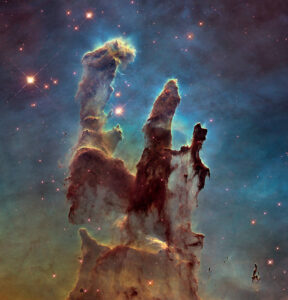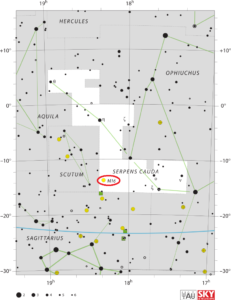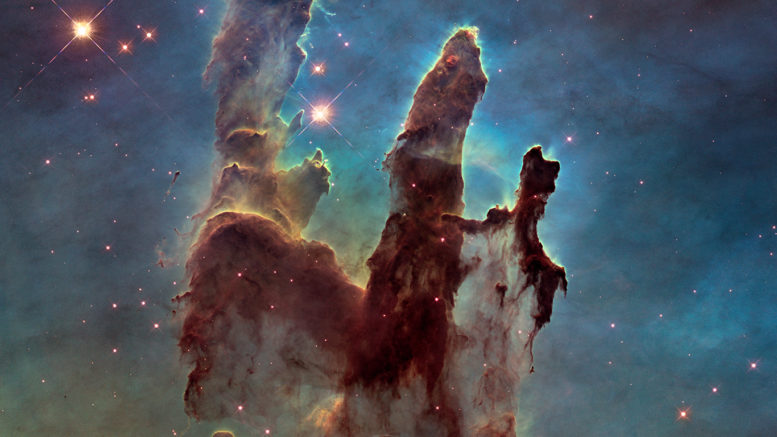Messier 16 the famous Eagle Nebula, is a star-forming nebula with a young open star cluster located in Serpens. Messier 16 is maybe most famous for the Hubble photo showing the Pillars Of Creation, which lies at the heart of M16. These tendrils of cosmic dust and gas are part of an active starforming region within the nebula and hide newborn stars in their wispy columns.

| Description | |
| Visible From Pacific Northwest | April to Early September |
| Best Time To Observe | July |
| Minimum Size Of Viewing Device | Small Telescope |
| Object Type | Emissions Nebula With Open Cluster |
| Designations | Eagle Nebula, Messier 16, M16, NGC 6611, IC 4703, Star Queen Nebula, The Spire, Sharpless 49, RCW 165, Gum 83, Collinder 375, C 1816-138, CTB 51 |
| Right Ascension | 18h 18m 48s |
| Declination | -13°49′ |
| Constellation | Serpens |
| Absolute magnitude | -8.21 |
| Apparent magnitude | +6.0 |
| Apparent dimensions | Nebula is 30′ and cluster is 7′ |
| Object Radius | Nebula is 70×55 light years and cluster is 15 light years |
| Distance From Earth | 7,000 light years |
History
Messier 16 was discovered by the Swiss astronomer Jean-Philippe Loys de Chéseaux in 1745-46. He described the object as a “star cluster between the constellations of Ophiuchus, Sagittarius, and Antinous [now Scutum], of which RA is 271d 3′ 10″ and southern declination is 13d 47′ 20″.”
The nebula itself was discovered by Charles Messier on June 3, 1764. Messier described a “cluster of small stars, enmeshed in a faint glow, near the tail of Serpens, at little distance to the parallel of Zeta of this constellation; with an inferior telescope this cluster appears like a nebula.”
William Herschel observed the cluster on July 30, 1783 and noted, “Large stars with small ones among them; within a small compass I counted more than 50, and there must be at least 100 without taking in a number of straggling ones, everywhere dispersed in the neighborhood.”
Locating M16 In The Sky
One of the easiest ways to find M16 is to identify the constellation of Aquila and begin tracing the stars down the eagle’s back to Lambda. When you reach that point, continue to extend the line through to Alpha Scuti, then southwards towards Gamma Scuti. Aim your binoculars or image correct finderscope at Gamma and put it in the 7:00 position.
Another way to find M16 is by first locating the “Teapot” asterism in Sagittarius constellation, and then by following the line from the star Kaus Australis (Epsilon Sagittarii) – the brightest star in Sagittarius – to just east of Kaus Media (Delta Sagittarii). Another way to find the nebula is by extending a line from Lambda Scuti in Scutum constellation to Alpha Scuti, and then to the south to Gamma Scuti.

Viewing M16
It is worth noting that M16 is easily visible with good binoculars in good seeing conditions. Messier 16 is best seen in a low powered telescope. 4-inch instruments will resolve about 20 stars against several regions of nebulosity. The star cluster is quite easy to find, but the surrounding nebulosity requires extremely good viewing conditions and large aperture instruments. The famous Pillars of Creation can only be seen in 12-inch and larger telescopes.
Photographing M16
With a regular unmodified DSLR such as a Canon T3i, with great guiding and a large enough telescope, one can capture the Pillars of Creation. As far as deep-sky astrophotography targets go, the Eagle Nebula is quite big and bright; therefore, a short 30-second exposure enough to start recording the intense glow of the core. It is indeed possible to use just a DSLR to capture the Eagle Nebula, as the key to success is an adequate amount of integration time for a healthy signal-to-noise ratio.
Using a DSLR, only about 3 to 4 hours are required for imaging with each exposure being 3 minutes and an ISO of around 400, it is indeed possible to get an absolute stunning image using lights, darks, and bias images. Check out the galactic-hunter.com article for more details, but we have provided a summary here. This is a great galaxy to return to for astrophotographers as they advance as the image will only improve as the photographer, gear, and editing improves.
Sources And Further Reading
Descriptions of all of Messier Objects can be found here.
https://www.nasa.gov/feature/goddard/2017/messier-16-the-eagle-nebula
https://www.galactic-hunter.com/post/m16-the-eagle-nebula-the-pillars-of-creation

Leave a comment